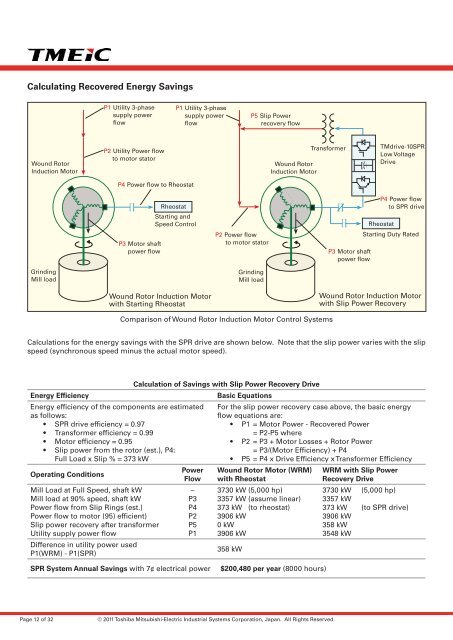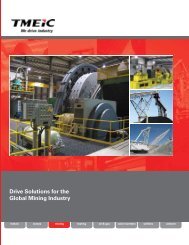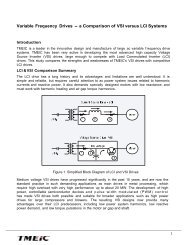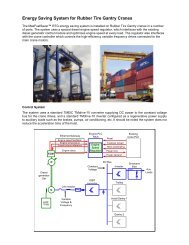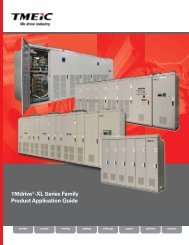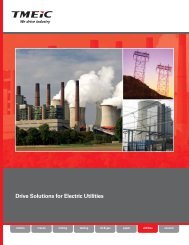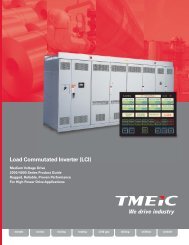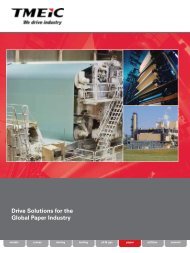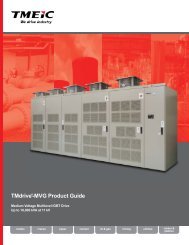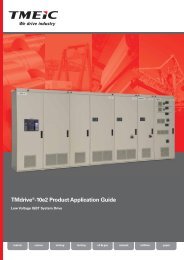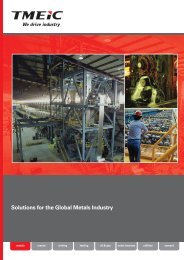Drive Solutions for the Global Mining Industry - Tmeic.com
Drive Solutions for the Global Mining Industry - Tmeic.com
Drive Solutions for the Global Mining Industry - Tmeic.com
Create successful ePaper yourself
Turn your PDF publications into a flip-book with our unique Google optimized e-Paper software.
Calculating Recovered Energy Savings<br />
P1 Utility 3-phase<br />
supply power<br />
flow<br />
P1 Utility 3-phase<br />
supply power<br />
flow<br />
P5 Slip Power<br />
recovery flow<br />
Wound Rotor<br />
Induction Motor<br />
P2 Utility Power flow<br />
to motor stator<br />
Wound Rotor<br />
Induction Motor<br />
Trans<strong>for</strong>mer<br />
TMdrive-10SPR<br />
Low Voltage<br />
<strong>Drive</strong><br />
P4 Power flow to Rheostat<br />
P3 Motor shaft<br />
power flow<br />
Rheostat<br />
Starting and<br />
Speed Control<br />
P2 Power flow<br />
to motor stator<br />
P3 Motor shaft<br />
power flow<br />
P4 Power flow<br />
to SPR drive<br />
Rheostat<br />
Starting Duty Rated<br />
Grinding<br />
Mill load<br />
Grinding<br />
Mill load<br />
Wound Rotor Induction Motor<br />
with Starting Rheostat<br />
Wound Rotor Induction Motor<br />
with Slip Power Recovery<br />
Comparison of Wound Rotor Induction Motor Control Systems<br />
Calculations <strong>for</strong> <strong>the</strong> energy savings with <strong>the</strong> SPR drive are shown below. Note that <strong>the</strong> slip power varies with <strong>the</strong> slip<br />
speed (synchronous speed minus <strong>the</strong> actual motor speed).<br />
Calculation of Savings with Slip Power Recovery <strong>Drive</strong><br />
Energy Efficiency<br />
Basic Equations<br />
Energy efficiency of <strong>the</strong> <strong>com</strong>ponents are estimated<br />
as follows:<br />
For <strong>the</strong> slip power recovery case above, <strong>the</strong> basic energy<br />
flow equations are:<br />
• SPR drive efficiency = 0.97<br />
• P1 = Motor Power - Recovered Power<br />
• Trans<strong>for</strong>mer efficiency = 0.99<br />
= P2-P5 where<br />
• Motor efficiency = 0.95<br />
• P2 = P3 + Motor Losses + Rotor Power<br />
• Slip power from <strong>the</strong> rotor (est.), P4:<br />
= P3/(Motor Efficiency) + P4<br />
Full Load x Slip % = 373 kW<br />
• P5 = P4 x <strong>Drive</strong> Efficiency x Trans<strong>for</strong>mer Efficiency<br />
Operating Conditions<br />
Mill Load at Full Speed, shaft kW<br />
Mill load at 90% speed, shaft kW<br />
Power flow from Slip Rings (est.)<br />
Power flow to motor (95) efficient)<br />
Slip power recovery after trans<strong>for</strong>mer<br />
Utility supply power flow<br />
Difference in utility power used<br />
P1(WRM) - P1(SPR)<br />
Power<br />
Flow<br />
–<br />
P3<br />
P4<br />
P2<br />
P5<br />
P1<br />
Wound Rotor Motor (WRM)<br />
with Rheostat<br />
3730 kW (5,000 hp)<br />
3357 kW (assume linear)<br />
373 kW (to rheostat)<br />
3906 kW<br />
0 kW<br />
3906 kW<br />
358 kW<br />
WRM with Slip Power<br />
Recovery <strong>Drive</strong><br />
3730 kW (5,000 hp)<br />
3357 kW<br />
373 kW (to SPR drive)<br />
3906 kW<br />
358 kW<br />
3548 kW<br />
SPR System Annual Savings with 7¢ electrical power<br />
$200,480 per year (8000 hours)<br />
Page 12 of 32<br />
© 2011 Toshiba Mitsubishi-Electric Industrial Systems Corporation, Japan. All Rights Reserved.


